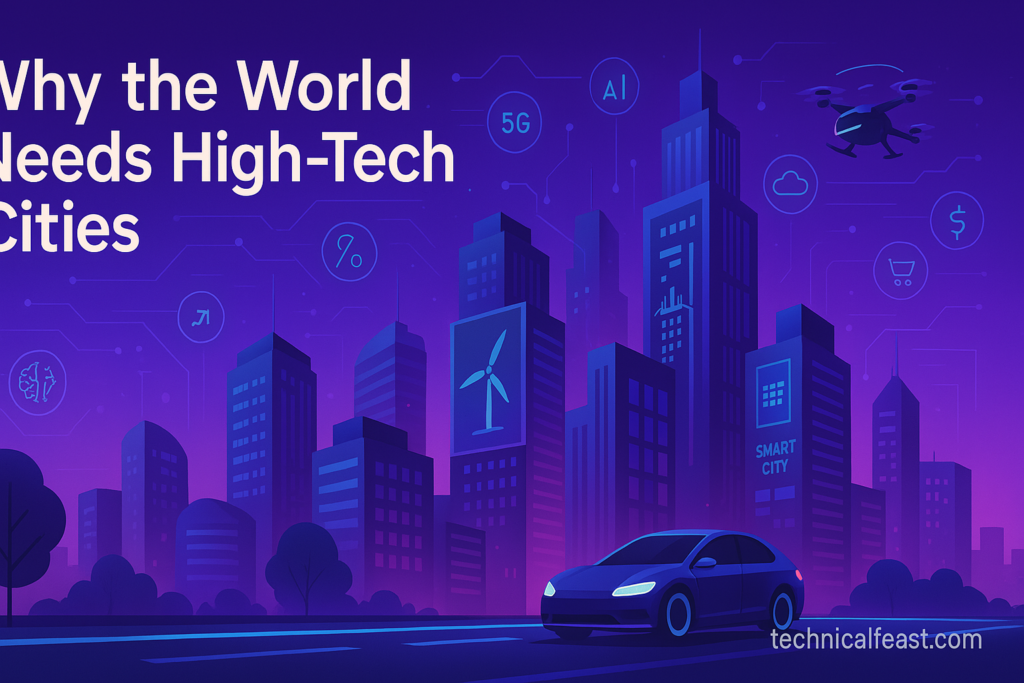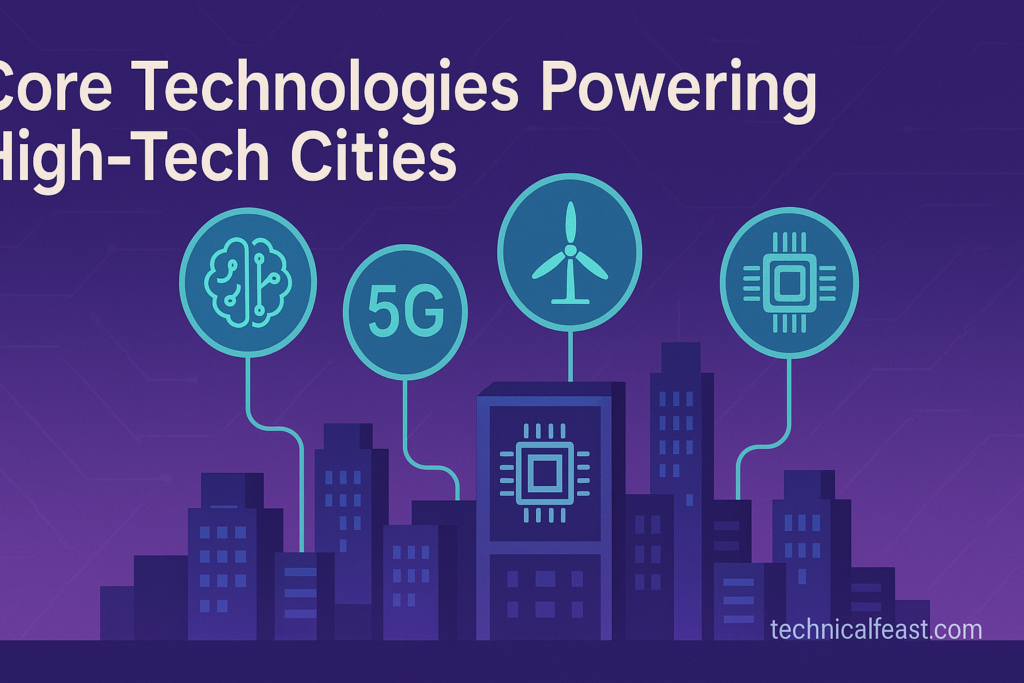The Rise of the High Tech City
I still remember my first trip to a high tech city. It wasn’t just the gleaming towers or driverless taxis that blew my mind. It was the sense that I had stepped into tomorrow. A place where technology wasn’t just cool — it was core. Everything from how I entered buildings to how I paid for my morning coffee had been touched by innovation.
But the story of the high tech city is bigger than just a flashy skyline. It’s a global movement — where cities are reimagining themselves to be smarter, faster, and more connected than ever before.
What Is a High Tech City? A Simple Definition
A high tech city is an urban space where digital technologies, data-driven systems, and smart infrastructure are deeply integrated into everyday life. From AI-powered traffic systems to IoT-enabled homes, these cities are designed to be efficient, sustainable, and livable.
Think of it like a city with a brain — a place where the internet isn’t just on your phone, it’s everywhere.
The Evolution of Urban Life: From Concrete to Code

Not long ago, cities were all about roads, buildings, and populations. The goal was expansion. But with rapid urbanization and technological breakthroughs, cities had to evolve.
That’s where the high tech city emerged — born from a need for smarter solutions to old problems like traffic jams, pollution, and overpopulation.
In places like Seoul, Singapore, and San Jose, digital transformation became the foundation for public services, security, healthcare, and business.
Real-Life Examples of High Tech Cities
1. Singapore: The Smart Nation
Singapore is the poster child for high tech city innovation. With facial recognition at airports, smart street lighting, autonomous buses, and a national AI strategy, it’s a living tech lab.
2. Shenzhen, China: The Silicon Valley of Hardware
What once was a fishing village is now the hardware capital of the world. Drones, robots, electric vehicles — everything is made and tested here in real time.
3. Tallinn, Estonia: Digital Governance at Its Best
This small European city leads in e-governance. You can vote, pay taxes, and even start a business online — all from your couch.
4. Bengaluru, India: The Tech Hub of the East
Often called the “Silicon Valley of India,” Bengaluru combines a booming IT industry with a startup-friendly environment. And now, with smart traffic systems and tech-integrated metro, it’s pushing toward becoming a full-fledged high tech city.
Life in a High Tech City: A Day in the Future
Let’s walk through a typical day in a high tech city, shall we?
7:00 AM — Your smart home lights up based on your sleep cycle. The air purifier adjusts to outdoor pollution levels, and the coffee starts brewing.
8:30 AM — You hop into a driverless electric cab. No traffic lights — AI manages intersections via real-time data.
9:00 AM — At work, facial recognition lets you in. Your desk adjusts ergonomically, and your holographic assistant updates you on meetings.
1:00 PM — Lunch? Ordered through a drone-delivered smart fridge app.
6:00 PM — Back home, your building uses solar panels and recycles greywater. You relax with immersive VR news and smart fitness tracking.
Now imagine millions living like this.
Why the World Needs High Tech Cities

It’s not just about gadgets. A high tech city can:
- Reduce traffic and pollution.
- Boost economic productivity.
- Make life safer and more inclusive.
- Use energy and resources more sustainably.
- Enable smarter governance.
With climate change, rising urban populations, and global competition, high tech cities aren’t just cool — they’re necessary.
Core Technologies Powering High Tech Cities

1. Internet of Things (IoT)
From smart bins to intelligent traffic lights, IoT devices collect and share data to optimize city functions in real-time.
2. Artificial Intelligence (AI)
AI helps in decision-making, security monitoring, traffic predictions, and even healthcare diagnostics.
3. 5G Connectivity
For real-time tech like autonomous cars or VR learning to work smoothly, 5G is crucial.
4. Big Data & Cloud
High tech cities thrive on data. Cloud platforms process vast volumes to support AI and analytics.
5. Blockchain
Used for secure digital IDs, smart contracts, and transparent governance.
Challenges in Building a High Tech City
Nothing this ambitious comes without hurdles.
- Data privacy concerns: With so many sensors, how much is too much surveillance?
- Cost of infrastructure: Smart cities need serious investment.
- Tech divide: Not everyone adapts to digital life equally.
- Cybersecurity: More tech = more vulnerabilities.
But with great challenge comes even greater innovation.
High Tech City vs. Smart City: What’s the Difference?
While the terms are often used interchangeably, there’s a slight difference:
- Smart city focuses more on optimizing services like water, electricity, or traffic using tech.
- High tech city goes a step beyond — tech isn’t just a tool, it’s the identity. It’s where innovation is central to culture, economy, and governance.
Think of smart cities as tech-upgraded versions of old cities, while high tech cities are built around future-first thinking.
The Role of Startups in Shaping High Tech Cities
Many of today’s high tech innovations don’t come from governments — they come from startups.
From smart parking apps to drone delivery systems, startups are the agile problem-solvers creating solutions for hyper-urban futures. Cities like San Francisco, Tel Aviv, and Bangalore thrive on this startup energy.
FAQs: High Tech City
Q1. What is the meaning of a high tech city?
A high tech city is an urban area that deeply integrates advanced technologies such as AI, IoT, and automation into its infrastructure, services, and lifestyle to improve efficiency, sustainability, and quality of life.
Q2. Which is the most high tech city in the world?
Cities like Singapore, Seoul, and Tokyo are often considered the most high tech due to their innovation ecosystems, smart infrastructure, and digital public services.
Q3. How does a high tech city help the environment?
They use green tech like smart grids, clean energy, and AI-driven waste management to reduce carbon footprint and optimize resource usage.
Q4. Can India develop more high tech cities?
Absolutely. With tech hubs like Bengaluru, Hyderabad, and Pune already booming, the potential is massive — especially with the government’s Digital India initiative.
Q5. Is living in a high tech city expensive?
It can be, especially during early development. But as the tech scales and becomes part of public systems, costs often normalize.




Leave a Reply